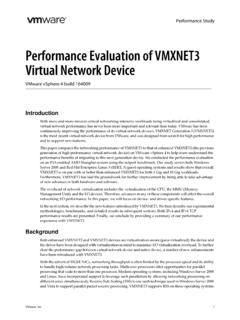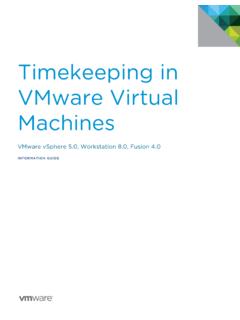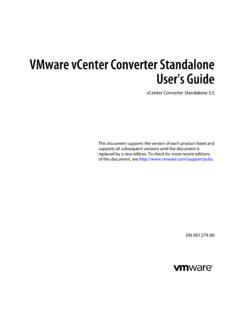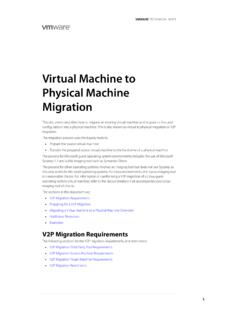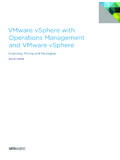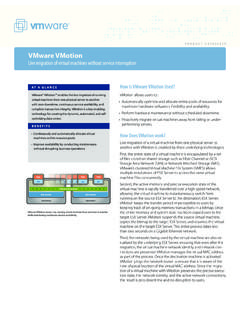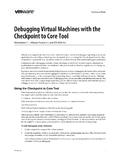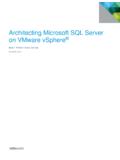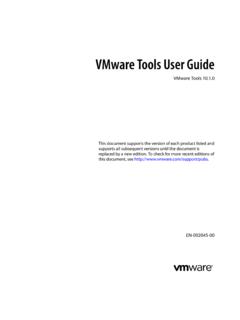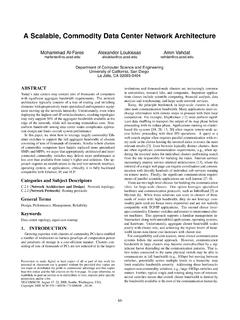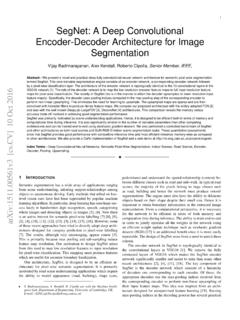Transcription of VMware Infrastructure Architecture Overview
1 VMware Infrastructure Architecture OverviewW H I T E P A P E R V M wa r e w h i t e pa p e rTable of ContentsPhysical Topology of the VMware Infrastructure Data Center ..4 Virtual Data Center Architecture ..5 Hosts, Clusters and Resource Pools ..6 VMware VMotion, VMware DRS and VMware HA ..7 Networking Architecture ..8 Storage Architecture ..9 VMware Consolidated Backup ..10 ESX Server External Interfacing Components ..10 VirtualCenter Management Server Architecture ..11 Conclusion ..13 V M wa r e w h i t e pa p e rVMware Infrastructure Architecture Overview Virtual Infrastructure Web Access A Web interface for virtual machine management and remote consoles access VMware VMotion Enables the live migration of running virtual machines from one physical server to another with zero downtime, continuous service availability and complete transaction integrity VMware High Availability (HA) Provides easy-to-use, cost-effective high availability for applications running in virtual machines.
2 In the event of server failure, affected virtual machines are automatically restarted on other production servers that have spare capacity VMware Distributed Resource Scheduler (DRS) Intelligently allocates and balances computing capacity dynamically across collections of hardware resources for virtual machines VMware Consolidated Backup Provides an easy to use, centralized facility for agent-free backup of virtual machines. It simplifies backup administration and reduces the load on ESX Server installations VMware Infrastructure SDK Provides a standard interface for VMware and third-party solutions to access VMware InfrastructureVMware Infrastructure includes the following components as shown in Figure 1-1: VMware ESX Server A production-proven virtualization layer run on physical servers that abstract processor, memory, storage and networking resources to be provisioned to multiple virtual machines VMware Virtual Machine File System (VMFS) A high-perfor-mance cluster file system for virtual machines VMware Virtual Symmetric Multi-Processing (SMP) Enables a single virtual machine to use multiple physical processors simultaneously VirtualCenter Management Server The central point for configuring, provisioning and managing virtualized IT infra-structure Virtual Infrastructure Client (VI Client)
3 An interface that allows administrators and users to connect remotely to the VirtualCenter Management Server or individual ESX Server installations from any Windows PCVM ware InfrastructureEnterprise Storage Enterprise ServersEnterprise NetworkESX ServersVirtual SMPVMFSV irtual MachinesOSAppOSAppOSAppOSAppOSAppOSAppOS AppOSAppOSAppOSAppVirtualCenter Management ServerConsolidatedBackup DRSHA what is Virtualization and what are Virtual Machines?Virtualization is an abstraction layer that decouples the physical hardware from the operating system to deliver greater IT resource utilization and flexibility. Virtualization allows multiple virtual machines, with heterogeneous operating systems ( , Windows 00 Server and Linux) and applications to run in iso-lation, side-by-side on the same physical virtual machine is the representation of a physical machine by software.
4 It has its own set of virtual hardware ( , RAM, CPU, NIC, hard disks, etc.) upon which an operating system and applications are loaded. The operating system sees a consistent, normalized set of hardware regardless of the actual physical hardware components. VMware virtual machines contain advanced hardware features such as 64-bit computing and virtual symmetric more information on virtualization, please read the Virtualization Overview VMware white Infrastructure is the industry s first full infrastruc-ture virtualization suite that allows enterprises and small busi-nesses alike to transform, manage and optimize their IT systems Infrastructure through virtualization. VMware Infrastructure delivers comprehensive virtualization, management, resource optimization, application availability and operational automa-tion capabilities in an integrated 1-1: VMware Infrastructure4V M wa r e w h i t e pa p e rThe following sections describe the Architecture of VMware Infrastructure , beginning with the elements that make up its physical topology, followed by the virtual, or logical, view of VMware Infrastructure where the relationships between the virtual architectural elements and the physical world are explored.
5 Lastly, the architectures of two core VMware Infrastructure components are discussed in further detail. Physical Topology of the VMware Infrastructure Data CenterWith VMware Infrastructure , IT departments can build a virtual data center using their existing industry standard technology and hardware . There is no need to purchase specialized hardware. In addition, VMware Infrastructure allows users to create a virtual data center that is centrally managed by management servers and can be controlled through a wide selection of 1-2: VMware Infrastructure Data Center Physical Building BlocksPhysical ServersESX ServerESX ServerESX ServerManageVirtualCenter Management ServerOSAppOSAppOSAppOSAppOSAppVirtual MachinesOSAppOSAppOSAppOSAppOSAppVirtual MachinesOSAppOSAppOSAppOSAppOSAppVirtual Machinescluster1host1 VMVMVMVMVMVMVMRP1RP3RP2datastoresnetwork Anetwork BServerGroup 1 ServerGroup 2 ServerGroup 3 OSAppOSAppVirtual MachinesOSAppESX ServerOSAppOSAppiSCSIS torageArrayNASS torageArrayFiber ChannelStorageArrayFiber Channel Switch Fabric / IP NetworkTerminalWebBrowserVIClientVirtual CenterManagementServerFigure 1-3.
6 VirtualCenter Management Server centrally manages the assign-ment of virtual machines to physical serversStorage Networks and ArraysFiber Channel SAN arrays, iSCSI SAN arrays and NAS arrays are widely-used storage technologies supported by VMware Infrastructure to meet different data center storage needs. Sharing the storage arrays between (by connecting them to) groups of servers via storage area networks allows aggregation of the storage resources and provides more flexibility in provi-sioning them to virtual NetworksEach computing server can have multiple gigabit Ethernet network interface cards (NICs) to provide high bandwidth and reliable networking to the entire data ServerThe VirtualCenter Management Server provides a convenient single point of control to the data center.
7 It runs on Windows 00 Server to provide many essential data center services such as access control, performance monitoring and configuration. It unifies the resources from the individual computing servers to be shared among virtual machines in the entire data center. As shown in Figure 1- , VirtualCenter Management Server accom-plishes this by managing the assignment of virtual machines to the computing servers. VirtualCenter Management Server also manages the assignment of resources to the virtual machines within a given computing server based on the policies set by the system Figure 1- shows, a typical VMware Infrastructure data center consists of basic physical building blocks such as x86 comput-ing servers, storage networks and arrays, IP networks, a manage-ment server and desktop clients.
8 Computing ServersThe computing servers are industry standard x86 servers that run VMware ESX Server on the bare metal. Each computing server is referred to as a standalone Host in the virtual environ-ment. A number of similarly configured x86 servers can be grouped together with connections to the same network and storage subsystems to provide an aggregate set of resources in the virtual environment, called a Cluster. V M wa r e w h i t e pa p e rComputing servers will continue to function even in the unlikely event that VirtualCenter Management Server became unreachable ( , the network is severed). Computing servers can be managed separately and will continue to run their assigned virtual machines based on the resource assignments that were last set. Once the VirtualCenter Management Server becomes available, it can manage the data center as a whole again.
9 The Architecture of VirtualCenter Management Server will be described in detail in later ClientsVMware Infrastructure provides a selection of interfaces for data center management and virtual machine access. Users can choose the interface that best meets their needs: Virtual Infrastructure Client (VI Client), Web Access through a Web browser, or terminal services (such as Windows Terminal Services or Xterm).Virtual Data Center architectureVMware Infrastructure virtualizes the entire IT Infrastructure including servers, storage and networks. It aggregates these heterogeneous resources and presents a simple and uniform set of elements in the virtual environment. With VMware Infrastructure , IT resources can be managed like a shared utility and dynamically provisioned to different business units and projects without worrying about the underlying hardware differences and limitations.
10 Figure 1-4: Virtual Data Center ArchitectureAs shown in Figure 1-4, VMware Infrastructure presents a simple set of virtual elements used to build a virtual data center: Computing and memory resources called Hosts, Clusters and Resource Pools Storage resources called Datastores Networking resources called Networks cluster1host1 VMVMVMVMVMVMVMRP1RP3RP2datastoresnetwork Anetwork B Virtual machines A Host is the virtual representation of the computing and memory resources of a physical machine running ESX Server. When one or more physical machines are grouped together to work and be managed as a whole, the aggregate comput-ing and memory resources form a Cluster. Machines can be dynamically added or removed from a Cluster. Computing and memory resources from Hosts and Clusters can be finely parti-tioned into a hierarchy of Resource are virtual representations of combinations of underlying physical storage resources in the data center.
